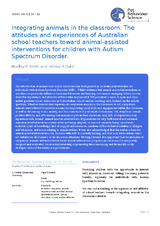Mostrar el registro sencillo del ítem
Integrating animals in the classroom: The attitudes and experiences of Australian school teachers toward animal-assisted interventions for children with Autism Spectrum Disorder
| dc.contributor.author | Smith, Bradley P | |
| dc.contributor.author | Dale, Ashley A | |
| dc.date.accessioned | 2016-04-15T09:17:37Z | |
| dc.date.available | 2016-04-15T09:17:37Z | |
| dc.date.issued | 2016 | |
| dc.identifier.issn | 2445-2874 | |
| dc.identifier.uri | http://hdl.handle.net/10396/13420 | |
| dc.description.abstract | The introduction of animals into school classrooms has been posited as a beneficial intervention for individuals with Autism Spectrum Disorder (ASD). Whilst evidence that animal-assisted interventions or activities can positively influence classroom behaviour and learning outcomes is emerging, little is known about the experiences and attitudes of those who implement it. We presented a series of open and closeended questions via an online survey to Australian school teachers working with students on the autistic spectrum. Whether teachers had experienced companion animals in the classroom or not, companion animals were believed to provide a means for improving social skills and engagement within the classroom, as well as decreasing stress, anxiety, and the occurrence of problematic behaviours. Yet, despite an overall positive attitude, and 68% having had animals or pets in their classroom, only 16% of respondents had experience with ‘formal’ animal-assisted interventions. Explanations for why both formal and informal animal-assisted interventions were either not being adopted, or was not currently being considered, included a lack of knowledge, lack of support and resources, reactions of the student in relation to allergies and behaviour, and issues relating to animal welfare. It was also acknowledged that the evidence-base for animal-assisted interventions for students with ASD is currently lacking, and that such interventions were not suitable for all students, or all classroom situations. Moving forward, it is important that the inclusion of companion animals and more formal based animal intervention programs in classrooms be adequately designed and evaluated, because implementing or promoting time consuming and financially costly strategies without the evidence is problematic. | es_ES |
| dc.format.mimetype | application/pdf | es_ES |
| dc.language.iso | eng | es_ES |
| dc.publisher | Universidad de Córdoba, Departamento de Medicina y Cirugía Animal | es_ES |
| dc.rights | https://creativecommons.org/licenses/by-nc-sa/4.0/ | es_ES |
| dc.source | Pet Behaviour Science 1, 13-22 (2016) | es_ES |
| dc.subject | Animals | es_ES |
| dc.subject | Companion animals | es_ES |
| dc.subject | Animal-assisted activities | es_ES |
| dc.subject | Autism Spectrum Disorder | es_ES |
| dc.subject | Special education | es_ES |
| dc.subject | School | es_ES |
| dc.subject | Teacher attitudes | es_ES |
| dc.title | Integrating animals in the classroom: The attitudes and experiences of Australian school teachers toward animal-assisted interventions for children with Autism Spectrum Disorder | es_ES |
| dc.type | info:eu-repo/semantics/article | es_ES |
| dc.relation.publisherversion | http://www.uco.es/ucopress/ojs/index.php/pet/index | es_ES |
| dc.rights.accessRights | info:eu-repo/semantics/openAccess | es_ES |

